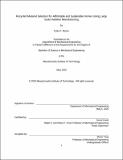Recycled material selection for affordable and sustainable homes using large scale additive manufacturing
Author(s)
Mynio, Erika P.
Download1197626763-MIT.pdf (1.213Mb)
Other Contributors
Massachusetts Institute of Technology. Department of Mechanical Engineering.
Advisor
David Hardt.
Terms of use
Metadata
Show full item recordAbstract
Worldwide estimates indicate nearly 150 million people are homeless, and 1.6 billion lack adequate shelter. One of the biggest barriers of home ownership is cost, which is often driven heavily by the cost of materials required. Plastic waste is also at an all-time high, with over 5 billion tons of plastic on the earth's surface and in its oceans. This waste will take hundreds of years to degrade if not longer and incentives and use for recycled plastic is needed now more than ever. Making lightweight homes using 3D printed recycled polymer materials is proposed as a solution to this problem. Assuming a network of manufacturing sites, a significant number of homes could be produced, raising the issue of material selection and availability. After creating an extensive comparison of potential materials, stressing properties, availability and cost, the best candidate appears to be polyethylene terephthalate (PET). Recycled PET (rPET), is available in volumes comparable to the projected demand for low cost housing. rPET material properties optimize the feasibility, processing, and engineering use qualities of the building material, but further testing is necessary to explore the effect of feedstock processing and additives on the performance of the material. This thesis examines the choice of (rPET) as the best potential material for large scale 3D printing of low-cost homes and presents an experimental setup for confirming this hypothesis.
Description
Thesis: S.B., Massachusetts Institute of Technology, Department of Mechanical Engineering, May, 2020 Cataloged from the official PDF of thesis. Includes bibliographical references (pages 58-63).
Date issued
2020Department
Massachusetts Institute of Technology. Department of Mechanical EngineeringPublisher
Massachusetts Institute of Technology
Keywords
Mechanical Engineering.